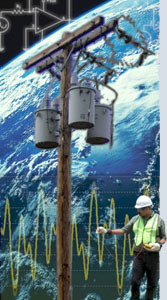Shocking at a Home Renovation
Kershaw, South Carolina, USA
Background
A utility customer's home was being renovated and the HVAC contractor was feeling a shocking sensation while installing the ductwork in the crawlspace of the house.
Possible Causes
The initial investigation considered several possibilities:
- Faulty wiring on the customer side.
- Open or damaged underground system neutral.
Action Taken
The possible causes were ruled out by:
- Temporarily de-energizing the customer's wiring by pulling the power meter.
- Inspecting the system neutral because the are of the home is subject to tree-related damage.
The next step in the investigation was to measure the shocking voltage. The shocking voltage was measured at 10.0 VAC from the metal duct to the soil under the house.
The next step was to measure the current and the neutral-to-earth voltage (NEV). Normally, the decreasing NEV values indicate that the shocking voltage is related to the load. However, the load on the overhead single-phase line was moderate. The pole ground-rod and meter ground-rod current readings were 0.10 amps and 0.12 amps, respectively. These low current readings indicated that the current was not exiting or entering the system at the customer location. The results of the measurements are shown in Table 1. The current readings indicate that the circuit three-phase load was balanced. The current measured on the customer's tap was not excessive.
 |
| Table 1: Measurements Taken at Various Points in the Circuit |
The next step was to review the neutral size. The neutral size from the tap (point A) to a point close to the customer (point C) was #6 copper wire. From that point to the customer, the neutral size was #2 ACSR.
Solutions
The solution was to increase the system neutral size from point A to point C. The increased neutral size would reduce the shocking voltage by reducing the neutral voltage drop. An alternate solution was to install underground counterpoise wire at the customer location to lower the NEV.

